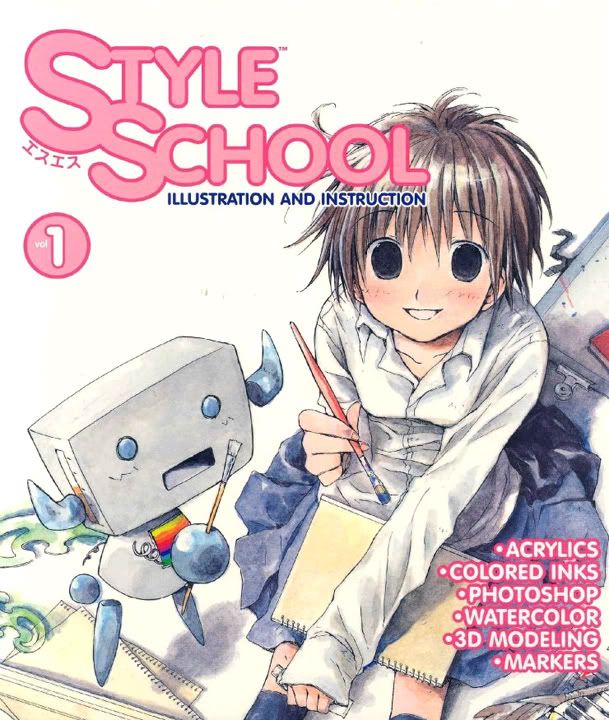 Style School: Illustration and Instruction (V. 1)
Style School: Illustration and Instruction (V. 1)Publisher: Dark Horse
Writer: Various
Art: Various
Style? Style is an overrated thing and an overused term. Style is the last thing you should be worrying about as an artist. Once you learn the basics, once you’ve mastered the act of creating art (which is a lifetime thing), you’ll discover you have what passes for style. While I hate arguing from analogy because it’s difficult to be precise, think of it this way: jeans are perennially popular and the substance of what makes up a pair never changes, but year after year, the superficial elements do. One season, it’s boot cut or flares, two seasons later and you’re trying to squeeze into low-waisted skinny jeans.
We can extend the analogy to cover cars, motorcycles, houses, anything where function is an element along with form. Cars and houses (and possibly clothes) are built from the inside out, and so it goes especially with comic book art. Audience tastes change but the core elements remain the same, whether you’re making a picture with a pencil on paper or using a tablet and Adobe Photoshop, whether you’re trying to emulate Leonardo da Vinci or Yazawa Ai.
That’s why I can never understand why some Western comic book fans get so bent out of shape about manga-influenced style elements creeping into art. “Manga artists can’t draw!” they shout. “They don’t shade! There’s no detail!” They’re too uptight about the superficial, they’re not seeing that 1) whether you’re Japanese or American or whatever, the art fundamentals remain, 2) the percentage of “bad” artists is probably about the same in the West as it is in Japan and 3) there are a lot of Japanese artists who can flat out draw. And draw like maniacs, kitty cats. In his lifetime, Kojima Goseki was every bit the storyteller Will Eisner was, few artists can match Takahashi Rumiko for appeal, and then you have ace renderers like Urasawa Naoki, Otomo Katsuhiro and Shirow Masamune. I don't see how anyone can compare the flacid work of some of the most fashionable American pros these days and not be blown away by certain Japanese comic book artists.
Looking at the art in Style School, Dark Horse’s translation of SS Magazine, I believe we’re only scratching the surface. The artists represented here are incredibly young and many of them—working in a variety of styles—are producing work of professional quality. And the media they work in! They don’t limit themselves to just pencils and ink. They use markers, acrylics, watercolors, computers and some media defying easy categorization—paper cutouts? Oils?
Some of their illustrations have a slick air-brushed quality, while others are loose and flowing, more fine art than comic book. Grasp of anatomy varies, but many of these artists work in complex backgrounds in near-flawless perspective and show superior understanding of color theory. When you see some of these kids are only 18 years old, or even 17, it’s doubly impressive.
The book passes itself off as an instructional work, and each opening chapter allows a single artist to describe his or her (the percentage of female artists represented is heartening; American comics tend to be a boy’s club) chosen process. Babiry explains the use of Copic markers, foo* goes with Photoshop, Yoshitugi paints with colored inks. The artist named Imperial Boy uses 3D and 2D software to make a detailed illustration of a girl confessing a crush to a boy, both of them standing on a light-infused train platform full of miniscule detail. I especially like Noa's ethereal watercolor technique.
The step-by-step sections are somewhat useful, but the book assumes you already know drawing basics. There’s nothing on penciling or doing your finished inks before adding color, nothing on figure construction or placing your characters in perspective. On the other hand, you’re not told to make eyes large or noses smaller. Instead, the focus is on short descriptions of specific techniques you can adapt to your own personal drawing aesthetics, Western or Japanese. And then inspiration from your talented fellow amateur artists. If you feel confident, the book tells you how you can submit your work to SS Magazine in Japan and possibly dazzle eyes from across the Pacific. For me, the instruction level is just about right, but its usefulness will vary according to your needs. For a beginner, it’s probably too advanced with not enough building block how-to info, and for an advanced student, there’s not enough breadth. I could use an entire volume devoted solely to marker techniques.
The other thing about the manga world, though, is there are dozens of instructional books that can get you to this point. The Comickers series is probably a bit more for the hardcore manga artist wannabe, but those looking for inspiration will get a lot out of Style School.
Oh, and the final section consists of advertisements for some of Dark Horse’s manga offerings. This may or may not interest you, but DH certainly takes the best of all possible worlds and puts it in front of you without cultural snobbery or defensiveness and for that, I applaud their catholic approach. Come on, people—comics are comics, no matter where they’re from!

No comments:
Post a Comment